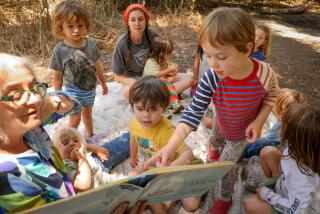The mysteries of Madrona Marsh are revealed to Torrance school teachers.
- Share via
The sun was just burning through the clouds when a group of about 40 teachers from elementary and middle schools throughout Torrance--wearing shorts, T-shirts, blue jeans, sneakers and climbing boots--gathered across the street from Madrona Marsh.
They were met that Thursday morning by Walton Wright, the city’s naturalist, who would lead them on a field trip of the city’s 43-acre seasonal wetland.
The teachers, many of whom carried binoculars and pencil and paper, were there to learn enough about the marsh’s wildlife and vegetation so that they can show other teachers how to lead their students on similar field trips.
Not long after the field trip began, a group of about 10 teachers spotted a light brown fox walking beside a fence about 70 yards away. Later, as the group entered dense bulrushes and shrubbery, they spotted dozens of tiny green- and gold-colored tree frogs hopping around their feet.
“I’m amazed,” Mary Marra, an eighth-grade teacher at Lynn Middle School, said as she tried to spot nearby Sepulveda Boulevard over the tules and cattails. “You wouldn’t know there were about 900 cars going by on Sepulveda.”
The field trip is part of a federally funded program to educate teachers about science. The teachers volunteered to spend three weeks discussing ecology, botany and astronomy and participating in field trips.
The program’s $167,480 grant from the United States Department of Education will also pay for computers, lasers and a planetarium in a new science center at the district’s Levy Center. Teachers hope to open the center to Torrance students by September.
Among the field trips in the three-week program was a visit to the TRW Inc. aerospace research facility in Redondo Beach, said Walteria Elementary School teacher Kay Griffith. There teachers saw the Hubble space telescope, which is to be sent into space on one of the space shuttle flights. Last week, the group toured the Hyperion sewage treatment plant near El Segundo to learn about water pollution.
Thursday’s trip through Madrona Marsh was intended to give teachers a hands-on lesson in ecology.
Joe Rizzo, a third-grade teacher at Arlington Elementary School, said the field trip made him feel more confident in his ability to teach children about nature and wildlife.
Jeneice Houze, a fifth-grade teacher at Lincoln Elementary School, said she plans to bring students to the marsh this year to teach them about the wildlife and the delicate balance of nature there.
At a clearing just east of Madrona Avenue, Wright halted and pointed out hundreds of mounds of dirt next to gopher holes in the sandy soil. He said the marsh has “the most gophers I’ve seen anywhere.”
Later, as the teachers studied the dry brush on the northeast section of the marsh, Wright told the group that many people have abandoned domesticated rabbits and ducks at the marsh. The animals usually are eaten by foxes, said the botanist who seems quite at home among the grass, willows and weeds.
“There are a lot of people who put (the animals) out in the natural habitat thinking it is good for them,” he said. “That really doesn’t work. They get wiped out.”
The walk through the marsh was not without its more common diversions. Soon after the teachers passed through the rusty chain-link gates to the marsh, the conversation among several turned to recipes for zucchini bread, the high price of a face lift and the deadly fear of snakes.
“Are there any snakes here,” asked a woman in a blue T-shirt and blue jeans as she poked through some tule and brush along the side of a path.
“If there are, stay by me,” said another teacher, who wore dark glasses. “I have the best snake alarm: I just see a snake and I scream. I can get the whole Torrance Fire Department here.”
When the 2 1/2-hour walk was over, Wright stopped just outside of the gates of the marsh.
“They were just like any other class,” he said as the teachers began to walk back to their cars. “Some could care less about what I said. Some looked bored.
“But the frogs were the big eye-catcher because the frogs are the creepy, crawling things they like.”
More to Read
Sign up for Essential California
The most important California stories and recommendations in your inbox every morning.
You may occasionally receive promotional content from the Los Angeles Times.














